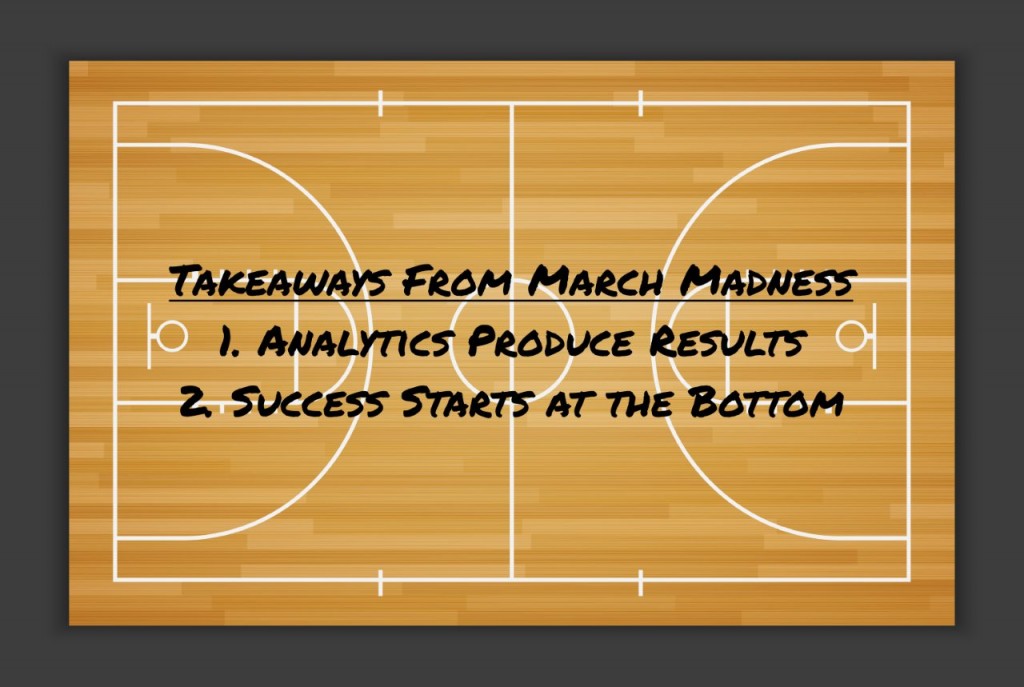 March Madness kicks off this week, and with it arrives one of the few times a year that both sports fanatics and the people who can’t tell Larry Bird from Larry Page come together to watch (and bet on) sports.
March Madness kicks off this week, and with it arrives one of the few times a year that both sports fanatics and the people who can’t tell Larry Bird from Larry Page come together to watch (and bet on) sports.
Tweet: 2 lessons wine and spirits distributors can learn from March Madness
For the wine and spirits industry, March Madness is a good time for spring promotions. In addition, tourney time has a lot to offer for the resourceful wine and spirits distributor. Below, I detail two lessons to be learned from March Madness, and how business intelligence can turn these lessons into results.
1. Analytics Produce Results
Every year, certain powerhouses progress far into the tournament. These teams have a variety of coaching styles, schemes, and philosophies; however, they all have one thing in common—superior talent. These schools are relatively uninteresting to look at. Their continued success can be attributed to acquiring the best recruits year after year.
The teams that interest me, though, are the ones that emerge out of nowhere to have success several years in a row. Most recently, this was the Butler Bulldogs under Coach Brad Stevens. Butler made it to the championship game two years in a row in 2010 and 2011, despite being previously unheralded. The secret to their success: an unquenchable thirst for analytics among the coaching staff. By promoting an atmosphere that prioritized a data-driven strategy rather than old-school hunches, Coach Stevens was able to take his team to new heights in very little time.
Wine and spirits distributors can use this same lesson to their advantage. By tapping into the analytic capabilities of a business intelligence tool, key business decisions become result-oriented. Analytics gives “powerhouse” distributors the staying power necessary to stave off the competition, and can catapult small or mid-size players into the spotlight.

2. Success Starts at the Bottom
A corollary to the ability of a relative unknown like Butler rising to the top, is that sometimes the giants do fall. Every year, some of the top seeds in the tournament make a first round exit. The tournament’s propensity for upsets is one of the major reasons people follow it so fervently. Any team can lose any game.
Nevertheless, it is important to note that the teams that do get upset are not simply victims of random chance. Every year, you hear the losing coaches attribute their stunning losses to their teams looking past their current opponent. Sometimes, teams simply get caught up in the madness.
Similarly, the best efforts of a wine and spirits company can fall flat if their analytics efforts succumb to madness. A lack of proper data governance in a distributor is analogous to a team looking past its current opponent. A win in the first round is a necessary before a win in the second round is possible, yet teams look past this. In much the same way, distributors try to launch robust analytics programs without proper data governance. With increasing supply chain complexity and a burgeoning emphasis on programs, it is becoming easier by the day to communicate misstated or trivial results. A flashy analytics package is not going to provide meaningful insights unless the business rules underlying the results are sound. A business intelligence tool can help to ensure that business rules are at the core of every dashboard and statistic that makes it to the key decision makers. With a proper focus on governance, distributors can avoid messy “first-round upsets.”
Did you find these lessons useful? Are there any takeaways from March Madness that you think we missed? Who are you rooting for this year? Let us know in the comments, and if you want to learn more about how Diver has helped wine and spirits distributors implement well-governed analytics efforts, check out some of our case studies.
- DiveTab Mobile BI: What’s New and What’s to Come - October 20, 2016
- 3 Online Resources to Help Sharpen Your Analytics Skills - August 9, 2016
- 5 Must-Haves in a Mobile BI Solution - August 1, 2016


